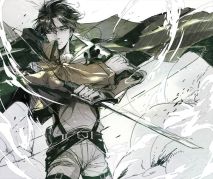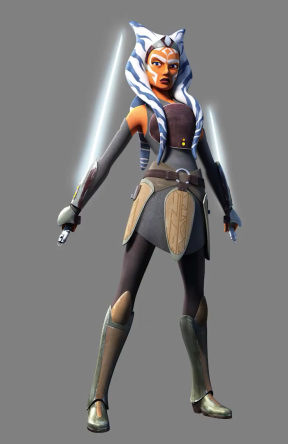Sorry for the delay – summer’s usually a pretty busy time for me, but I am happy to announce I’ve not really done *any* OT in months, so I’m feeling refreshed. I’m going to take a moment to talk about something that I think that often times, fantasy does very well – and that’s utilizing not only underdogs, but in the epic struggle of good versus evil (or grey vs grey) having a healthy sense of comeuppance. Yes, there might be unicorns and dragons, but here’s one of my favourite quotes from Gandalf.

But we’re not here for philosophy. It’s time to talk heavy hitters, and for me, the most logical place to start is talking about those who have powers beyond that of normal human beings, and we’ll work our way backwards to the very mortal but greatest swordsman or what have you.
I’ve said before I’m not the biggest person into superheroes. Others have pointed out that with the retelling of the story of Spiderman and Superman, started to embody classic archetypes that can reach across cultures. I’ve heard more than one person talk about Marvel and DC being the new Greek Mythology, and given how many times we can reboot a series, let’s say I’m not unconvinced.
I watched One Punch Man because of this video. For those who ain’t gonna watch it, it sets up the titular character, Saitama, as a hero so strong, he can solve any of the usual problems, usually with a single punch. He gets no thrill out of fighting so he’s bored but continues to fight as he can easily mop the floor with creatures other elites find daunting. He’s not in it to do the right thing – Saitama is in it for fun. There’s no climax, because after you’ve seen the first few episodes, we know how things are going to end, and in order for us to emotionally invest in the story line, we have to look at other characters who aren’t one hit and it’s over. I’m going to go into character struggle in the next part of this series. If you’re looking for something fun to watch, I recommend it.
Alongside superheroes, I find using magic can be a bit of a cop out if I don’t give myself clear guidelines as to what the rules are. In my upcoming book, Witchslayer’s Scion, magic is utilized, but it’s not clearly understood by the protagonists – they know some, but not all of the rules, and the mages generally keep a lot of what they do secret even from one another so other mages can’t work against them. That’s all and good to keep the reader guessing, because the reader will speculate and fill in some of the blanks naturally. From a writer’s perspective, I had to know not only what spells were more powerful, but what happened when certain spells hit one another – would they negate, or have a certain reaction? I had to come up with strict rules about how things worked, so I could understand how a weaker mage might try to stand up to a more powerful one, so it’s consistent when the mages start getting tapped out and it doesn’t seem to take place for the necessity of plot.
Do I have to follow things to their logical conclusions?
To me, the reasoning of why John Carter retained his human strength on Mars didn’t work given the movie’s interpretation of the source material, but it is fun to watch him learn how to walk. There’s plenty of fun speculating how powers can be a real game changer, whether it’s doing seemingly normal activities, or, parodied.
Moving to normal human beings – this means you can make a character tougher than normal, but you can’t have them breaking all the rules for the sake of making them look badass, because it can play inconsistent when they need to be captured or detained for plot purposes.
I don’t know about the rest of you, but it really irks me when a character is very powerful, and made weak to move the story along. It doesn’t bother me if they have an injury and succumb to it, like Baron Godfrey’s character in Kingdom of Heaven. In Witchslayer’s Scion, I utilize rapid healing via touch. While throwing a potion at a character works in a Final Fantasy game, in story, I knew it could easily become a game changer if left unchecked. How I kept it interesting is giving different healers different abilities and, making a person’s response to healing dependent on their own health. And not gonna lie – I used it in the first place so I could have characters go through action sequences and not have chronic injuries plague them for the remainder of the series.
Not all Fighters are the Same
Just because someone is good at a certain type of physical activity doesn’t necessarily preclude them to all activities. Consider The Hunger Games – one would think it would be to your advantage to be a fighter – but the truth is, fighting is brutal and there’s a good chance you’ll sustain an injury even if you win. It’s been a while since I’ve read the books, but to my knowledge many previous “winners” survived by living off the land and outlasting other players. Some badasses have skills or stats that make them better in some circumstances than others – a very noble knight might excel at carrying out the king’s justice, but a sell sword might be better at dealing with a troublesome courtier in a way that doesn’t look like murder. Let’s plop these two down in the bush for a week – not hostile living conditions, but not easy to trap and eat, either. Suddenly, being a big strong knight with a revving metabolism isn’t as much as an advantage as the smaller sell sword who is used to going days between meals, and scavenging isn’t taking the same toll on him as the knight. Even if both are obtaining the exact same amount of calories and shelter, my gut tells me Prince Valiant is burning more calories for the exact same activity, at least initially.
Back to my example from last week – I made Rain a character that excels at fighting, especially with a blade. Another character, Ataro, is shorter and weaker than Rain, but I made him a better hand to hand fighter – not that his punches were better, but in a grapple, Ataro not only has more tricks, Ataro has no qualms about playing dirty. In general, I have it that what Ataro lacks in power, he makes up for in technique Neither of these characters are weaklings, but all things being equal, Rain would win if it was simply a strength competition.
So how else might I make a fight between these characters interesting, assuming neither has the home team advantage?
I establish early on in his book, that Rain isn’t a good swimmer – he can tred water slowly, but that’s about it. Utilizing water in a fight scene makes the stakes higher for him. I’ve established Ataro is sneakier – he might go out of his way to lure Rain to a location where he can use shadows or make it so that Rain’s no longer can utilize his strength – I don’t like gimmicks, but if Rain is only used to fighting on firm ground, and suddenly has to swashbuckle atop a sinking ship’s deck, a less skilful swordsman but lifelong sailor will probably beat him if they can hold him off and get him off balance. Go back in rewrites, throw out a line or two that implies Ataro is a sailor or very nimble, and it doesn’t feel forced.
Here’s some basic questions to ask:
Who has the better stamina?
Who can take the most damage?
Who can sprint the fastest?
Who has the best reaction time?
They are disarmed and must fight unarmed. Who can grapple? Do they know any holds or other techniques?
Now, there’s no accounting for dumb luck – watch videos on sparring on youtube, and you’ll see how short fights generally are, because things happen quickly. Things that look epic in fights usually tend to look impressive but not be effective. So it is natural, then, that often when we see a character who stands out on tv, that they appear to be in a different stance or grip then other characters, as illustrated below.

Scout

Major Character

Levi is the best Titan Killer in Attack on Titan. There’s something unsettling about Levi’s bored gaze, and reverse grip. I know my pictures should be better, but watching him in the anime, you see he is different, even compared to other elites.
Kendo is the only swordmanship I’ve ever really studied – and I didn’t get to do it terribly long before I went back to school and that swallowed up my life for several years, but here’s a quick reference to the five stances.

The first stance is actually nuetral – you can defend or attack from it. The second and third are aggressive – you easily move from a strike position. The third is defensive – if someone strikes, you can knock their blade to the side. I never studied the last – we called it the “hidden” stance. I can’t tell you it’s advantages or disadvantages, but it seemed extremely intimidating to a beginner like me.
Let’s take a look at an extremely famous series, and get a sense of what we see with how these characters are holding.

Standard Jedi pose. We know canonically, that Anakin is one of the greatest jedi fighters. This isn’t technically a pose he would probably take in fighting, but it invokes he can either attack or defend here.

Back to a reverse grip. It’s eerie – this stance leaves her open, but she would probably not face someone with a blade in this stance. This strikes me more as position five in kendo, hidden pose. Once again – don’t watch this show – but here’s a sequence of these two characters fighting together. Watch how they move in the scene. (FYI, Vader dominates the fight with the kid before she shows up). Flips aside that should get Ashoka hacked to bits, you can see a very different style between the two of these characters.
Of course, going for flash and excitement first will have you over analyzed. This is the internet, afterall.
Admittedly, I wouldn’t get hung up on the choreography when I’m writing as compared to a more visual medium, but let’s end with something fun. I don’t watch Game of Thrones (wanna finish the books first – go ahead and point out the show will have an ending, first) but this fight sequence is great. With lightsabers, well, because, but you can see visually Dayne is dangerous right from the get go – fighting with twin swords (extremely tricky) and the reverse grip, he stands out from everyone else in that scene. As writers, we don’t have camera angles and music at our disposal to make the sequence more dynamic, so I say focus on what you do have, and worry about the fight making sense first, even if it’s two lightweights or two titans.







